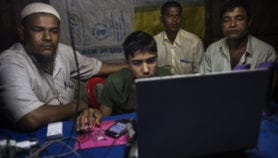Send to a friend
The details you provide on this page will not be used to send unsolicited email, and will not be sold to a 3rd party. See privacy policy.
The Simputer — a cheap, pocket-sized computing device designed for use by rural populations in India — has been hailed as a breakthrough in bringing the world of computing to the poor. But with delays in production, escalating development costs and a dearth of buyers, can this idealistic project ever be pulled off?
From lab to village
When the prototype was first announced two years ago by researchers at the Indian Institute of Science in Bangalore, the Simputer captured imaginations across the world. It was heralded as a way to help the poor and illiterate join the information age, and many predicted it would bridge the digital divide in a country with a billion people, but only a few million computers.
Two years on, the laboratory dream is on the verge of becoming a full-blown commercial enterprise. Two Bangalore-based bodies now oversee the Simputer’s development and production: the established IT company Encore and BEL-PicoPeta, an alliance between public sector giant Bharat Electronics and a start-up launched by the original research team. While the device has yet to go on sale in retail outlets, it has been used in pilot projects in the states of Karnataka and Chhattisgarh with promising results.
The Simputer is a handheld computing device with a touch-sensitive screen that can carry out many of the services carried out by ‘normal’ computers. In addition, it can function in several Indian languages, and a single device can be easily shared by a number of users in the same village.
It may be tempting to see the Simputer as just another handheld computing device such as a PalmPilot. But Simputer’s supporters say that while the size may be similar, the device is hardly an executive toy. “You won’t find handhelds with comparable computing power at anything like this price,” says Edward Cherlin, a California-based designer of multilingual websites. “None of these devices can replace Simputer in its target niche – support for the poor of India in their own languages.”
Language is crucial to the design of a device whose name stands for “simple, inexpensive, multilingual computer”. Along with all the familiar services — email, audio files, Internet access and so on — plans are in place for the Simputer to provide text-to-speech systems for several indigenous languages, a boon for the 35 per cent of Indians who cannot read. Other applications, such as telemedicine services, micro-banking, information access geared to farmers and distance education for remote schools, are being tailored to rural development needs. All in all, it’s a package that could make a big impact in communities that currently have no access to information technology.
Opening up technology
The Simputer diverges even more significantly from the world of Microsoft when it comes to licensing arrangements. By using Linux, a licence-free operating system, Simputer aims to break with the bonds of monopoly ownership, reflecting a growing movement that seeks to treat knowledge as a ‘global public good’. In practice, this means that users do not need to pay large amounts for software.
In a ploy to speed up the device’s development, Simputer’s backers are doing all they can to encourage software developers to add their own improvements to its design.
“We had to create a unique architecture and platform and convince solution developers to work on it,” explains Shashank Garg, vice-president of Encore. The effort appears to be paying off.
Even the Simputer’s hardware design is ‘open source’. Anyone can download it from the Internet for personal use (although commercial exploitation means hefty payouts of US$25,000 for companies in the developing world, and ten times that in industrialised countries). And perhaps this is where the real innovation lies.
 |
Last December, dozens of bright young software developers assembled in Bangalore — India’s Silicon Valley — to learn how to develop applications for the Simputer. These individuals are granted exclusive rights to their innovation, but only for one year of commercial production. After that time it is placed in the public domain. This approach not only rewards innovation, but also keeps the door open to a continually evolving design.
Finding a market
It all sounds like techno-heaven. India’s incredible success in the IT sector is finally being channelled towards benefiting the country’s poor. But can the Simputer survive the rigours of the commercial world?
Its backers are uncompromisingly optimistic. “The poor are a largely neglected market,” argues Encore CEO Vinay Deshpande. “But they too have a huge commercial potential.” Work is already underway to explore markets for the Simputer outside India, he explains, with the Middle East and Africa looking most promising.
“Our experience has been that the basic need for bridging the digital divide exists in each of these [regions], and local communities have appreciated the Simputer as a concept that could be applied to help solve their problems,” adds Garg.
But their experience to date suggests that such markets are hard to tap into. Many feel that those living on less than a dollar a day are unlikely to be persuaded to fork out US$215 — the current market price for a basic Simputer — no matter how many ‘additional features’ it boasts.
Proponents counter with the argument that the Simputer is a ‘sharable’ device, which can be jointly owned by several people. “Even if a Simputer costing Rs 10,000 (US$215) is too costly, ten villagers could come together to own one,” Deshpande explains. Others envision schemes where one device would be owned by a community, kept by the local shopkeeper or teacher, and accessed by villagers via smartcards, which at US$2 are much more affordable.
Current challenges
Development of the Simputer is clearly at a critical juncture. Orders are beginning to pick up, but the devices are still being produced on a ‘made-to-order’ production schedule. To date, just 600 Simputers have been sold. And while some of the teething troubles have now been sorted out, questions remain over its robustness and reliability.
There is an underlying sense of disappointment among some of its developers, despite their optimism. “While several of the original claims may have been met, I wouldn’t be satisfied until the product reaches the rural masses in vast numbers,” says Garg. “So it is still too early to start congratulating ourselves.”
PicoPeta’s CEO Swami Manohar blames a lack of financial support from the government and other agencies. “The major problem has been the non-realisation of our belief that once prototype Simputers were demonstrated there would be a huge groundswell of support [from these bodies].”
Nevertheless, many believe that its backers deserve praise in attempting to make a real contribution to bringing people in remote rural areas into the digital age. Not only this: they are also championing an ethically sound approach in a sector of industry known for its hard-nosed business mentality.
“The idea is that we Indians can develop [advanced] technology appropriate to the needs of the rural masses if some of us are able to devote a portion of our time and technology into projects with a social conscience,” he says.
That’s all very well. But if the Simputer story is anything to go by, propelling rural India into the digital age is a complex and challenging business — and very much a full-time job.Frederick Noronha is a Goa-based freelance journalist, who is interested in the developmental potential of information technology.













